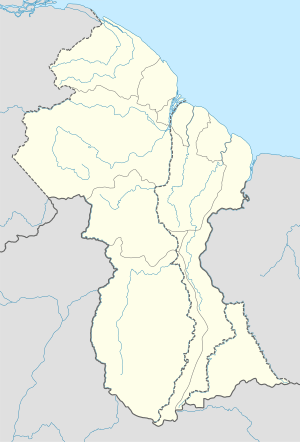Victoria, Guyana
Victoria is located on the Atlantic coast of Guyana, 29 kilometres (18 mi) east of Georgetown and bordered by Cove and John to the west and Belfield to the east. It was the first village in Guyana to be bought by the combined resources of Africans who had recently won their freedom from slavery.
Victoria | |
|---|---|
village | |
 Victoria Location in Guyana | |
| Coordinates: 6.7510°N 57.9661°W | |
| Country | |
| Region | Demerara-Mahaica |
| Population (2012)[1] | |
| • Total | 2,912 |
| Time zone | UTC-4 |
| Climate | Af |
The community was initially established as a plantation called Fort Wellington. In November 1839, 83 ex-slaves from five nearby estates (Douchfour, Ann's Grove, Hope, Paradise and Enmore) pooled their resources and bought Plantation Northbrook for 30,000 guilders, or $10,283.63. Each of the 83 owned one lot of land. After its purchase it was renamed Victoria, presumably in honor of England's Queen Victoria,[2] although some suggest it may have been named as such in honor of the freed slaves' victory.[3]
It is credited with one of the first codes of local government in Guyana, established in 1845.[4] The village grew up to become one of the leading exporters of products made from coconuts and cassava.
The first church built there, a Congregationalist church, named after William Wilberforce, the abolitionist, was erected in 1845.[5] A memorial tablet was placed in the church honoring William Africa Baptiste, known as 'Boss Africa', who became accepted as the Father of the village. Baptiste, who died in 1881, was the first village schoolmaster.[5] Wilberforce Congregational Church at Victoria still stands today.
Pioneering Guyanese playwright, Bertram Charles was born in Victoria and in 1963, organized a series of Creole Breakfasts in order to stimulate artistic and cultural life in the area. This is still and annual event that continues today.[6]
William Nicholas Arno's History of Victoria Village gives an account of the origins and development of the village.[7]
Notes
- Guyana Jottings
- The Village Movement Chapter 54
- Article from Guyana Tribune, reprinted at Land of Six Peoples
References
- "2012 Population by Village (Zipped – 18.3 MB)". Statistics Guyana. Retrieved 15 August 2020.
- "54. THE VILLAGE MOVEMENT".
- "Another hit- from Guyana: Land of Six Peoples".
- "Archived copy". Archived from the original on 2006-06-27. Retrieved 2006-04-23.CS1 maint: archived copy as title (link)
- "Victoria Village". Guyana Times Interational. Retrieved 17 August 2020.
- "VICTORIA VILLAGE – A BREAKFAST WITH A PURPOSE". 17 July 2014.
- "'History of Victoria Village' –by William N. Arno". Guyana Chronicle. Retrieved 17 August 2020.